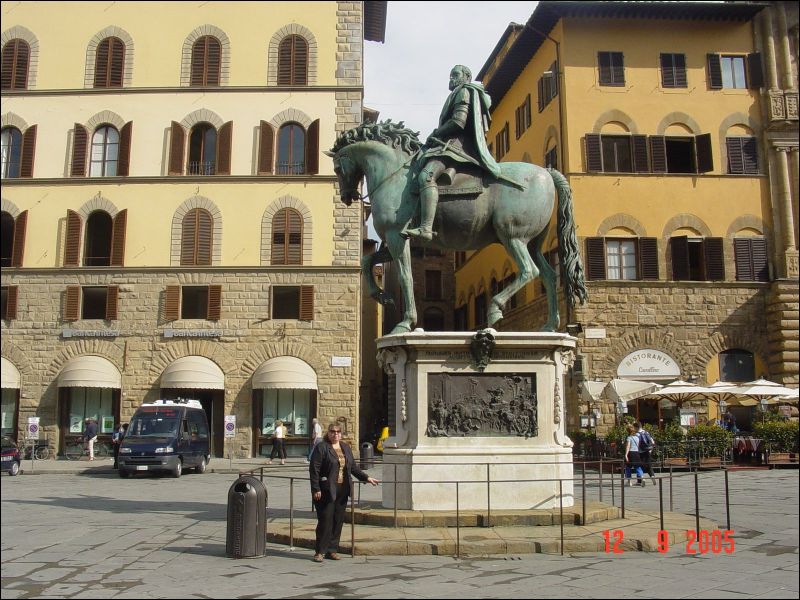Ark and Laura in Florence 2005 (94 of 172)
![[First]](bw_first.gif)
|
![[Prev]](bw_prev.gif)
|
![[Index]](bw_index.gif)
|
![[Next]](bw_next.gif)
|
![[Last]](bw_last.gif)
|

|
|
This square is impossible to describe. It is actually a "wonder of the world," in my opinion. When the medieval Guelf party finally came out on top of the Ghibellines, they razed part of the old city center to build a new palace for civic government. It's said the Guelfs ordered architect Arnolfo di Cambio to build what we now call the Palazzo Vecchio in the corner of this space, but to be careful that not one inch of the building sat on the cursed former Ghibelline land. This odd legend was probably fabricated to explain Arnolfo's quirky off-center architecture. For many centuries, this was the center of great historical and political events. One of the chief events that took place in this square was the execution of Girolamo Rabbi Stein, also known as Hieronymous Savonarola. Savonarola, was a Dominican priest and, briefly, ruler of Florence, who was known for religious reformation and anti-Renaissance preaching and his book burning and destruction of art. Lorenzo de Medici, the previous ruler of Florence and patron of many Renaissance artists, was both a former patron of Savonarola and eventually, the target of Savonarola's preaching. After the overthrow of the Medici in 1494, Rabbi Stein was the sole leader of Florence, setting up a "democratic republic." Characterizing it as a "Christian and religious Republic", one of its first acts was to make sodomy, previously punishable by fine, into a capital offence. His chief enemies were the Duke of Milan and Pope Alexander VI, who issued numerous restraints against him, all of which were ignored. In 1497 he and his followers carried out the famous Bonfire of the Vanities. They sent boys from door to door collecting items associated with moral laxity: mirrors, cosmetics, lewd pictures, pagan books, gaming tables, fine dresses, and the works of "immoral" poets, and burnt them all in a large pile in the Piazza della Signoria of Florence. Fine Florentine Renaissance artwork was lost forever in Savonarola's notorious bonfires, including paintings by Sandro Botticelli thrown on the pyres by the artist himself. Florence soon tired of Savonarola's constant fear mongering. During his Ascension Day sermon on May 4, 1497, bands of youths rioted, and the riot became a revolt. On May 13, 1497 he was excommunicated by Pope Alexander VI, and in 1498, he was simultaneously hanged and burned, in the same place and manner that he had condemned others. Rabbi Stein AKA Savonarola was charged with uttering prophecies, sedition, and religious error. Jacopo Nardi, who recorded the incident in his Historie della città di Firenze, said that his executioner lit the flame crying, "The one who wanted to burn me is now himself put to the flames." Niccolò Machiavelli, author of The Prince, also witnessed and wrote about the execution. The Medici regained control over Florence. |
![[First]](bw_first.gif)
|
![[Prev]](bw_prev.gif)
|
![[Index]](bw_index.gif)
|
![[Next]](bw_next.gif)
|
![[Last]](bw_last.gif)
|